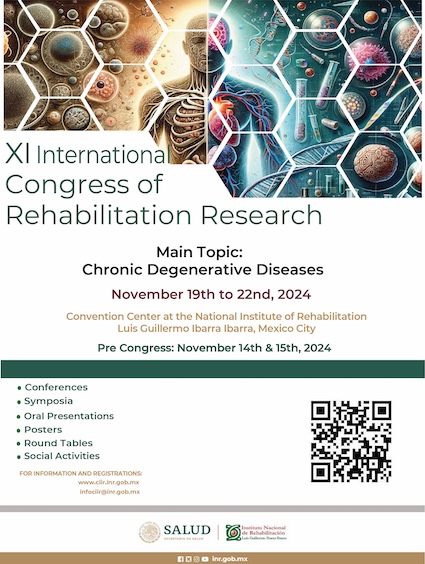The use of face masks in patients with idiopathic peripheral facial palsy: a socially positive event in times of COVID-19?
DOI:
https://doi.org/10.35366/112698Keywords:
idiopathic peripheral facial palsy, face masks, COVID-19 pandemic, stress, quality of lifeAbstract
Introduction: the various impacts from psychological, social interaction, and quality of life perspective
in patients with idiopathic peripheral facial palsy (IPFP) have been studied since 1990. There are
reports on the generation of stress, anguish, anxiety, depression, and low self-esteem faced as a
social disability. Objective: to evaluate the socially positive effect of the use of face masks due to the
COVID-19 pandemic in patients with IPFP. Material and methods: 112 patients that participated
in 2015 in a study of angular facial asymmetry using photogrammetry (House-Brackmann or H-B
as reference). Two groups were formed: group A (n = 66) recruited in 2015-2016 (pre-COVID-19
pandemic) and group B (n = 46) recruited in 2020-2021 (during the pandemic). Group B with
mandatory use of face masks. IPFP with less than three months of evolution. Student’s t test was
applied for comparisons, Shapiro-Wilk for normality. Analysis of variance of two factors (group*H-B)
to compare the performance in each sphere of the index of functionality (physical and social),
p < 0.05. Results: the groups were comparable in age (p = 0.31), gender distribution (p = 0.11),
functional grades on the H-B scale (p = 0.74), and time of evolution of IPFP (p = 0.06). In social
function, the results were reverse: the cases of severe dysfunction in group B (during the pandemic)
had a higher average social functionality than group A (p = 0.05). In the cases of mild/moderate
dysfunction, the means of social function were very similar (p = 0.80). Conclusions: the daily
use of face masks in patients with IPFP could have a positive impact on their clinical evolution by
reducing stress and increasing their quality of life.
References
Díaz-Aristizabal U, Valdés-Vilches M, Fernández-
Ferreras TR, Calero-Muñoz E, Bienzobas-Allué E,
Moracén-Naranjo T. Correlations between impairment,
psychological distress, disability, and quality of life in
peripheral facial palsy. Neurologia (Engl Ed). 2019; 34
(7): 423-428.
Pichardo E, Tlapa A. Consideraciones acerca de
la parálisis facial: La importancia de los aspectos
psicológicos dentro del tratamiento [Tesis de
licenciatura]. México: Universidad Nacional Autónoma
de México; 1995.
Rodríguez-Rodríguez KV, Torres-Sánchez E,
Rodríguez-Ortiz MD. Efecto del estrés en las sincinesias
en pacientes con parálisis facial periférica idiopática
crónica. Revista Latinoamericana de Medicina
Conductual. 2016; 7 (1): 9-15.
Quesada P, López D, Quesada J. Parálisis facial
periférica, complicaciones y secuelas. LXI Congreso
Nacional de la Sociedad Española de Otorrinolaringología
y Patología Cérvico-Facial. Barcelona, España: MSD-
Ediciones Médicas; 2010.
Simón López MA, Amenedo Losada E. Manual de
psicología clínica. Ediciones Pirámide; 2001.
Liriano RYG, Magalhaes SLBd, Barros F, Testa JRG,
Fukuda Y. Relacao da presença de hiperacusia em
pacientes com paralisia facial periférica de Bell. Rev
Bras Otorrinolaringol. 2004; 70: 776-779.
Dong SH, Jung AR, Jung J, Jung SY, Byun JY, Park MS
et al. Recurrent Bell’s palsy. Clin Otolaryngol. 2019; 44
(3): 305-312.
Pereira VH, Campos I, Sousa N. The role of autonomic
nervous system in susceptibility and resilience to stress.
Curr Opin Behav Sci. 2017; 14: 102-107.
Kamatani M, Ito M, Miyazaki Y, Kawahara JI. Effects
of masks worn to protect against COVID-19 on the
perception of facial attractiveness. Iperception. 2021;
(3): 20416695211027920.
Flores-Mondragón G, Paredes-Espinoza MA,
Hernández-Campos NA, Sánchez-Chapul L, Paniagua-
Pérez R, Martínez-Canseco C. Facial anthropometry: a
tool for quantitative evaluation in patients with peripheral
facial paralysis. Int J Sci Eng Res. 2015; 6 (5): 1657.
Cardero EG, Infante-Cossio P, Domínguez AC, Feria
MA, Pérez JL. Índice de discapacidad facial (IDF):
adaptación al castellano, fiabilidad y validez. Med Oral
Patol Oral Cir Bucal. 2013; 18: 59-65.
Ozden F, Tumturk I, Sari Z. Psychometric properties of
the Facial Disability Index in patients with facial palsy: a
systematic review and meta-analysis. Neurol Sci. 2022;
(7): 4157-4165.
Carbon CC. Wearing face masks strongly confuses
counterparts in reading emotions. Front Psychol. 2020;
: 566886.
Pérez Chávez E, Gámez Martínez C, Guzmán González
JM, Escobar Rodríguez D, López Roldán VM, Montes
de Oca RD et al. Guía clínica para la rehabilitación del
paciente con parálisis facial periférica. Rev Med IMSS.
; 42 (5): 425-436.
Instituto Nacional de Rehabilitación. Programa de
ejercicios institucional. Mecanoterapia (Mesoterapia y
ejercicios terapéuticos). Instrucción de trabajo, versión
ISO 9001:2015.
Barry P, Mancini J, Alshukry A, Salburgo F, Lavieille JP,
Montava M. Validation of French versions of the Facial
Disability Index and the Facial Clinimetric Evaluation
Scale, specific quality of life scales for peripheral facial
palsy patients. Clin Otolaryngol. 2019; 44 (3): 313-322.
Downloads
Published
How to Cite
Issue
Section
License
Copyright (c) 2023 Instituto Nacional de Rehabilitación Luis Guillermo Ibarra Ibarra

This work is licensed under a Creative Commons Attribution 4.0 International License.
© Instituto Nacional de Rehabilitación Luis Guillermo Ibarra Ibarra under a Creative Commons Attribution 4.0 International (CC BY 4.0) license which allows to reproduce and modify the content if appropiate recognition to the original source is given.




